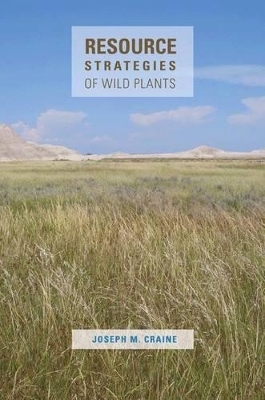
Resource Strategies of Wild Plants
Princeton University Press (Verlag)
978-0-691-13912-8 (ISBN)
- Lieferbar (Termin unbekannt)
- Versandkostenfrei innerhalb Deutschlands
- Auch auf Rechnung
- Verfügbarkeit in der Filiale vor Ort prüfen
- Artikel merken
Over millions of years, terrestrial plants have competed for limited resources, defended themselves against herbivores, and resisted a myriad of environmental stresses. These struggles have helped generate more than a quarter million terrestrial plant species, each possessing a unique strategy for success. Yet, as Resource Strategies of Wild Plants demonstrates, the constraints on plant growth are universal enough that a few survival strategies hold true for all seed-producing plants. This book describes the five major strategies of growth for terrestrial plants, details how plants succeed when resources are scarce, delves into the history of research into plant strategies, and resets the foundational understanding of ecological processes. Drawing from recent findings in plant-herbivore interactions, ecosystem ecology, and evolutionary ecology, Joseph Craine explains how plants attain available nutrients, withstand the immense stresses of drying soils, and flourish in the race for light.
He shows that the competition for resources has shaped plant evolution in newly discovered ways, while the scarcity of such resources has affected how plants interact with herbivores, wind, fire, and frost. An understanding of the major resource strategies of wild plants remains central to learning about the ecology of plant communities, global changes in the biosphere, methods for species conservation, and the evolution of life on earth.
Joseph M. Craine is assistant professor of biology at Kansas State University. He has conducted research throughout North America, New Zealand, Australia, and South Africa.
Preface xi Acknowledgments xv Abbreviations xvii CHAPTER 1: The Basis for Plant Strategies 1 Assessing Natural Selection 1 From Single Traits to Multitrait Strategies 5 Quantifying Plant Traits and Strategies 8 Ranking Strategies 9 Synthesis 13 CHAPTER 2: The History of Plant Strategies 15 Nutrients and the History of Plant Strategies 15 Grime 19 Chapin 26 Tilman 33 Laying the Foundation of Plant Strategies 41 CHAPTER 3: Stress and Disturbance 45 Defining Stress and Disturbance 45 Major Causes of Stress and Disturbance 48 How Herbivory Works 50 Growth in the Face of Stress and Disturbance 55 Responding after Stress and Disturbance 61 The Links to Resource Availability 62 Summary 62 CHAPTER 4: Resource Limitation 64 The Concept of Single-Resource limitation 65 History of the Nitrogen Cycle Concept 68 Pulses or Slow Bleeds? 75 Primer on the Phosphorus Cycle 79 Co-limitation in a Post-Liebigian World 80 Evaluating Costs in a Co-limited World 84 Trade-offs in Use Efficiency in a Co-limited World 87 Summary 89 CHAPTER 5: Competition for Nutrients and Light 91 Definitions and Types of Competition 92 Competition for Nutrients under Uniform Supplies 94 How Much Root Length? 104 Interference Competition 106 Competition for Nutrients under Heterogeneous Supplies 107 Competition for Light 109 Synthesis 114 CHAPTER 6: Comparing Negative Effects 119 Comparing Negative Effects 120 How to Measure the Importance of Stress and Disturbance in Environments 122 How to Measure the Importance of Stress and Disturbance in the Natural Selection of a Species 130 Importance of Factors at Low Nutrient Supply 132 Importance of Factors at High Nutrient Supply 139 The Relative Importance of Factors 145 Synthesis 146 CHAPTER 7: The Low-Nutrient Strategy 149 Physiological Traits 151 Whole-Plant Traits 169 Effects on Nitrogen Cycling 171 Revising the Low-Nutrient Strategy 173 Significance of Traits in Strategy 187 Synthesis 199 CHAPTER 8: The High-Resource Strategy 202 The Scope of This Chapter 204 Physiological Traits 205 Whole-Plant Traits 212 Effects on Nutrient Cycling 213 Revising the High-Resource Strategy 213 Significance of Traits in Strategy 217 Why the Race Ends 223 Synthesis 224 CHAPTER 9: The Low-Light Strategy 227 Physiological Traits 229 Whole-Plant Traits 233 Effects on Nutrient Cycling 236 Traits under High Light 236 Why These Patterns 239 The End of the Second Stage of Competition 246 Synthesis 248 CHAPTER 10: The Low-Water and Low-CO2 Strategies 251 Water 251 Carbon Dioxide 268 Summary 279 CHAPTER 11: A Synthesis of Plant Strategies 282 Application and the Way Forward 285 Genetics, Pleiotropy, and Plasticity 286 Limitation 287 Competition 289 Defense and Herbivory 290 Mechanisms of Coexistence 292 Biogeographic Patterns and Invasions 293 Global Change 295 Tree of Life 298 Bibliography 301 Index 327
| Erscheint lt. Verlag | 17.5.2009 |
|---|---|
| Zusatzinfo | 2 halftones. 37 line illus. 1 table. |
| Verlagsort | New Jersey |
| Sprache | englisch |
| Maße | 156 x 235 mm |
| Gewicht | 482 g |
| Themenwelt | Naturwissenschaften ► Biologie ► Botanik |
| Naturwissenschaften ► Biologie ► Evolution | |
| Naturwissenschaften ► Biologie ► Genetik / Molekularbiologie | |
| ISBN-10 | 0-691-13912-1 / 0691139121 |
| ISBN-13 | 978-0-691-13912-8 / 9780691139128 |
| Zustand | Neuware |
| Haben Sie eine Frage zum Produkt? |
aus dem Bereich


